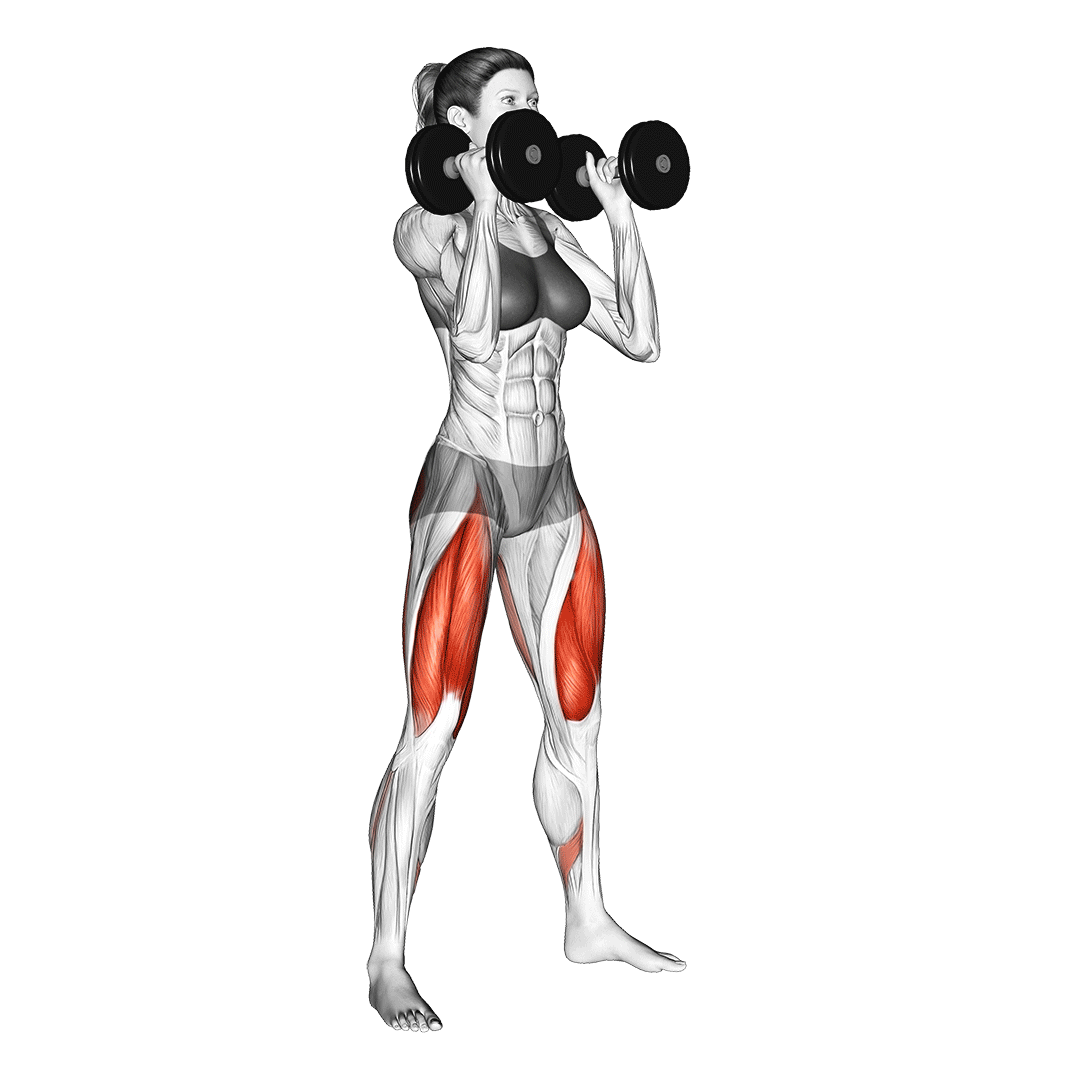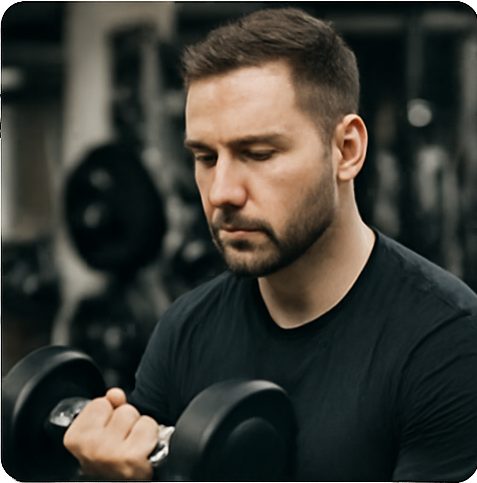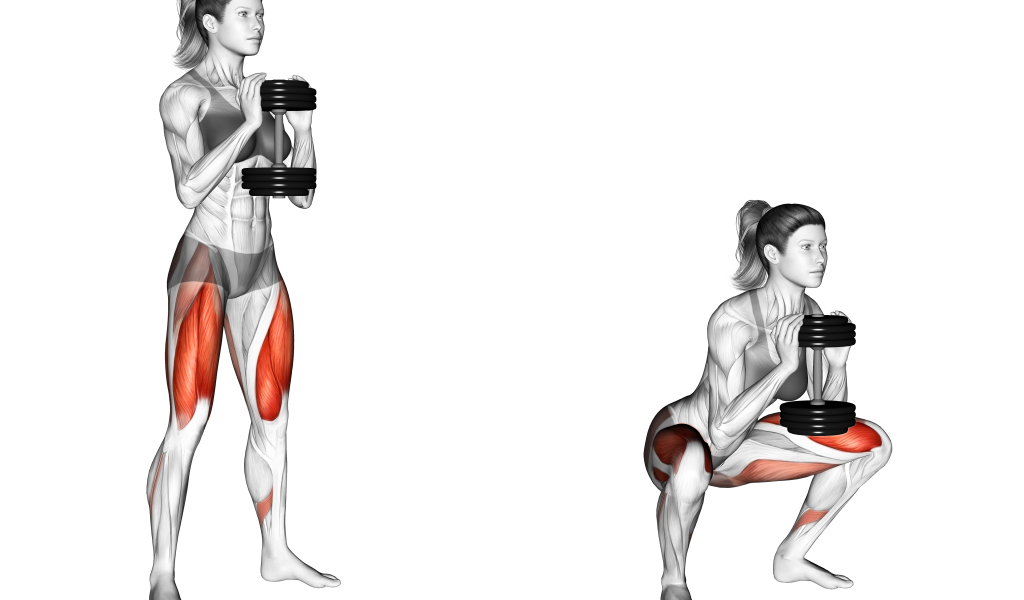I used to think dumbbell front squats were just something you did when the squat rack was busy. You know — a quick fix until the barbell opened up. But once I gave them a real shot in the gym, they totally surprised me.
At first, I couldn’t figure out the grip. My balance felt off and quads lit up in a different way. My core worked overtime. It actually felt harder — in a good way.
Now? Dumbbell front squats are part of my regular training. Not just a backup. They’re a legit lift with some serious benefits — especially in a commercial gym where you’ve got access to a full rack of dumbbells and space to move.
What Are Dumbbell Front Squats?
What the Proper Dumbbell Front Squat Looks Like
At first, I had no clue where to hold the dumbbells. I thought just hanging them by my sides would work. Nope.

The right way?
- You hold a dumbbell in each hand and rest them on your shoulders.
- Like, front-racked — elbows up, core braced, chest up.
- You don’t need to crush the grip — just let the bells sit there while you stay tall and controlled.
If you’re holding them down by your hips, that’s not the same thing. That’s more like a suitcase squat — still useful, but different muscles, different vibe.
Front-racked dumbbells = more core, more upright, more quad focus.
I Botched the Form — Here’s How I Fixed It
I messed this up hard when I started.
My elbows dropped halfway down, the dumbbells slid forward, and everything collapsed. Not fun.
Also, my wrists were screaming because I tried to “hold” the dumbbells instead of resting them. Once I found a more neutral grip and set the bells back on my shoulders, it felt way smoother.
Here’s what actually helped me dial it in:
- Filming myself from the side (this changed everything)
- Doing slow, paused reps at the bottom
- Starting light and focusing on clean reps over heavy weight
Now the setup feels natural — no wrist pain, no tipping forward, just solid reps.
Muscles You’ll Feel
Dumbbell front squats hit way more than I expected. It’s not just legs.
You’ll feel it mostly in:
- Quads — front-loaded weight forces your knees forward
- Core — you’ve gotta brace hard to keep upright
- Glutes — driving up from the bottom
- Upper back and shoulders — just holding the dumbbells forces posture work
Basically, it’s sneaky full-body training packed into a leg movement.
Who Should Use Dumbbell Front Squats?
Honestly? These work for almost anyone in a commercial gym.
Perfect if:
- You want to crush your quads but don’t want to wait around for a barbell
- You’re learning squat mechanics and want better posture control
- You’re dealing with barbell fatigue or shoulder mobility issues
- You need something that hits hard but is quick to set up between machines or supersets
They’re simple, scalable, and don’t take up much space. Way more useful than I gave them credit for.
Tracking Dumbbell Front Squats: I Messed This Up at First
How to Record the Weight
When I first logged dumbbell front squats, I didn’t know if I should write down the weight of one dumbbell or both. Turns out, most commercial gym apps or logs go by total weight.
So if I’m using two 40 lb dumbbells, I log 80 lbs total. Super simple — just double it unless your tracker says “per hand.”
The big thing? Just stay consistent. Whatever method you pick, keep it the same so your progress makes sense.
How I Actually Got Stronger at These
I didn’t go heavy right away. That would’ve wrecked my form.
Instead, I started with lighter weights and focused on higher reps — usually 3 sets of 10. Once I got the movement dialed in, I started pushing it a bit more.
Here’s what really helped:
- Paused squats — holding at the bottom for 2–3 seconds made my legs shake (in a good way)
- Supersets — pairing them with lunges or goblet squats for that burn
- Small weight jumps — just adding 5 lbs each week kept me progressing without crushing my form
And when I hit a plateau? I rotated them out for a few weeks (like with walking lunges), then came back. Felt way stronger.
Dumbbell vs. Barbell vs. Everything Else — What’s the Real Difference?
Dumbbell vs. Barbell Front Squats
At first, I thought dumbbell front squats were just filler. After actually doing both dumbbell and barbell a ton, here’s how I see it:
| Feature | Dumbbell Front Squats | Barbell Front Squats |
|---|---|---|
| Setup | Easy — grab and go | Slower — need a rack and space |
| Load Potential | Lighter overall | You can load it heavy, fast |
| Core Engagement | Wildly high — total ab burn | Still strong, just a bit less |
| Wrist/Elbow Stress | Way less (if your form’s good) | Can be brutal with clean grip |
| Stability Challenge | More — each hand works solo | More stable and “locked in” |
| Great For | Balance, posture, learning | Max strength, power work |
Bottom line? Dumbbell front squats are super underrated. Especially if you’re in a busy gym or want to clean up your squat form without messing with a rack.
Other Squat Alternatives I’ve Tried
Sometimes I want to mix it up — either to break a plateau or just give my joints a break. Here’s what I’ve tried and when I like to use them:
| Exercise | Similarity | When I Use It |
|---|---|---|
| Goblet Squat | Medium | Quick warm-up or burnout sets after leg day |
| Suitcase Squat | Low | For grip and core focus — not a leg main lift for me |
| Kettlebell Front Squat | High | Like dumbbells but shifts the feel — good variety tool |
| Front Rack Lunge | Medium | To build balance and single-leg drive |
Each one hits a little different, but dumbbell front squats are still my go-to when I want something clean, quick, and effective at the gym.
Dumbbell Front Squat Standards — What’s “Good” Anyway?
When I first started doing dumbbell front squats, I had no clue what counted as strong. Like… was I weak, average, or crushing it? So I did some digging — and here’s a quick cheat sheet based on what most lifters in commercial gyms are doing.
Male Dumbbell Front Squat Standards (lb)
| Strength Level | Weight | Bodyweight Ratio |
|---|---|---|
| Beginner | 18 lb | 0.10x |
| Novice | 42 lb | 0.25x |
| Intermediate | 76 lb | 0.45x |
| Advanced | 121 lb | 0.75x |
| Elite | 174 lb | 1.05x |
Female Dumbbell Front Squat Standards (lb)
| Strength Level | Weight | Bodyweight Ratio |
|---|---|---|
| Beginner | 13 lb | 0.10x |
| Novice | 25 lb | 0.20x |
| Intermediate | 42 lb | 0.30x |
| Advanced | 63 lb | 0.45x |
| Elite | 86 lb | 0.60x |
Quick notes:
- These are per hand, so total weight = double it.
- It’s not a strength competition — just a reference.
- What matters most? Consistency and clean form.
My experience tells me that it’s more about feeling than numbers. If it burned in the quads and crushed my core, I knew I was on the right track.
Dumbbell front squats surprised me — simple setup, serious results. If you train in a commercial gym, they’re 100% worth keeping in your rotation.

Hi, I’m the editor here at Leadman Fitness. We’re a manufacturer focused on producing top-quality barbells, plates, kettlebells, dumbbells, and strength training gear. I’ve been into sports and fitness for years, and I know my way around all kinds of gym equipment—both from using it and helping create it.
I spend a lot of time understanding the real problems people run into in the gym—whether it’s beginners trying to pick the right gear or experienced lifters looking for something more durable. I stay in close touch with our production team and talk directly with other equipment makers, so we’re always improving based on what real lifters and coaches are looking for.
What I share comes from hands-on experience—stuff that actually helps people train better, not just in theory, but in real gyms.
